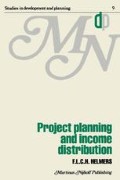Abstract
Under conditions of perfect competition, the market interest rate equates individuals’ marginal time preferences with the marginal rate of return on investment. But, in the real world capital markets have many `imperfections’. Corporate and personal income taxes, risk elements, government interventions, limited access to capital markets and monopoly elements are just a few of the many factors that drive a wedge between the time productivity of capital (the rates of return) and lenders’ time preference rates. In Chapter 3 we argued that when investments are optimal for the country as a whole, the opportunity cost of capital to the Government should be measured by the rates of return foregone in the private sector. This argumentation is valid under the stipulated condition. However, it may be possible that the investments of the country as a whole are considered suboptimal, and several writers have argued that in such a case public sector investment decisions should not be based on rates of return foregone in the private sector, but on a discount rate — which we shall call the social discount rate — that takes into account that investments should be promoted.
Access this chapter
Tax calculation will be finalised at checkout
Purchases are for personal use only
Preview
Unable to display preview. Download preview PDF.
Notes Chapter 8
Eckstein, O., ‘A Survey of the Theory of Public Expenditure Criteria’in ‘Public Finances: Needs, Sources and Utilization,’ A Conference of the Universities National Bureau Committee for Economic Research, published by Princeton University Press, Princeton, 1961, pp. 454–460.
Ramsey, F. P., ‘A Mathematical Theory of Savings,’ The Economic Journal, December 1928.
Marglin, S. A., ‘Public Investment Criteria,’ MIT Press, Cambridge, Massachusetts, 1967.
Lal, D., ‘Methods of Project Analysis: A Review,’ World Bank Staff Occasional Papers No. 16, distributed by The Johns Hopkins University Press, Baltimore and London, 1974, p. 29.
Musgrave, R. A., ‘Cost-Benefit Analysis and the Theory of Public Finance,’ The Journal of Economic Literature, September 1969, pp. 798–807.
Haq, M. ul, ‘Employment in the 1970s: A New Perspective,’ Speech at World Conference, Ottawa, May 1971.
Rights and permissions
Copyright information
© 1979 Martinus Nijhoff Publishing
About this chapter
Cite this chapter
Helmers, F.L.C.H. (1979). Intertemporal Income Distribution Aspects. In: Project planning and income distribution. Studies in development and planning, vol 9. Springer, Dordrecht. https://doi.org/10.1007/978-94-010-3722-8_8
Download citation
DOI: https://doi.org/10.1007/978-94-010-3722-8_8
Publisher Name: Springer, Dordrecht
Print ISBN: 978-94-010-3724-2
Online ISBN: 978-94-010-3722-8
eBook Packages: Springer Book Archive

